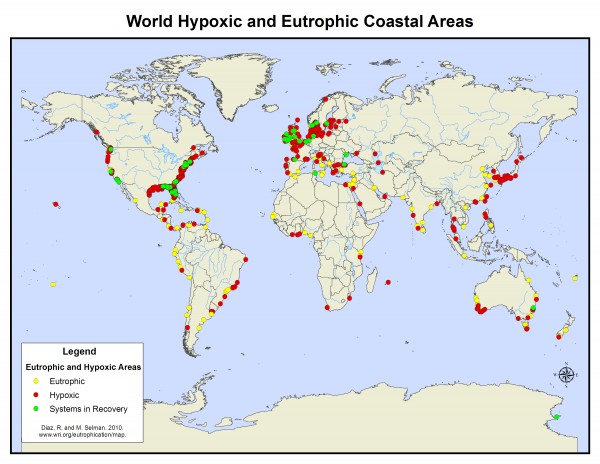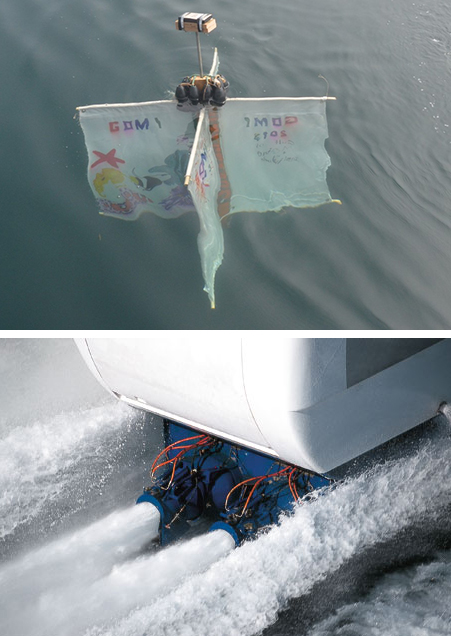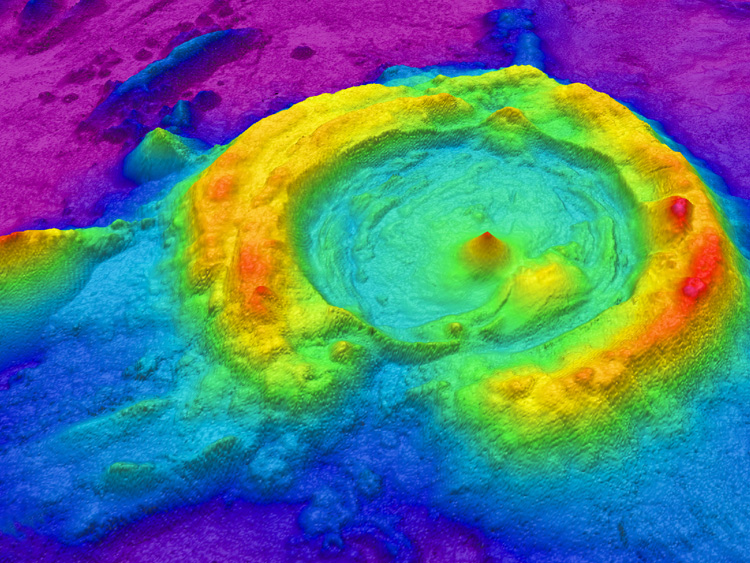PRE2015 4 Groep5: Difference between revisions
| Line 72: | Line 72: | ||
====Dead zones==== | ====Dead zones==== | ||
[[File:Deadzones.jpg|thumb|Dead zones in oceans around the world.]] | |||
Ocean dead zones are areas with low oxygen levels and hardly any marine life. These areas are caused by agriculture fertilizers that increase the level of nitrogen and phosphorus, also known as eutriphication. The result is a rapid increase in phytoplankton, because they are 'build' from phosphorus and nitrogen. These algal blooms cause deadzones. The number of deadzones is increasing. | Ocean dead zones are areas with low oxygen levels and hardly any marine life. These areas are caused by agriculture fertilizers that increase the level of nitrogen and phosphorus, also known as eutriphication. The result is a rapid increase in phytoplankton, because they are 'build' from phosphorus and nitrogen. These algal blooms cause deadzones. The number of deadzones is increasing. | ||
As a result, the fertility of the marine life drops dramatically, and in more extreme cases, fish fall unconcious and then suffocate. Slow moving creatures on the seafloor are unable to escape. | As a result, the fertility of the marine life drops dramatically, and in more extreme cases, fish fall unconcious and then suffocate. Slow moving creatures on the seafloor are unable to escape. | ||
Revision as of 15:48, 28 April 2016
Group members
- Aniceta, N.M.F (0876672)
- Boelsums, N.M (0964376)
- Brandts, A (0895917)
- Haenen, S.R.R (0889428)
- Kuijpers, J.J.L (0838617)
Introduction
Abstract
Problem statement
The need for mariculture come from the fact that the food production and food consumption are out scaling each other, the food consumption grows harder than the food production can cope with. [1]
Motivation
Seaweed has been farmed by humans for hundreds of years in Asia and on the west-coast of America. It's being sold more and more on the Western market these days and the demand for seaweed is increasing. More and more fishermen are converting to seaweed farms.
This can have troubling consequences. Seaweed, when farmed intensively, can reduce the water quality of coastal areas. Dense farming areas and seaweed monoculture increase the risk of diseases spreading. This is why we want to move the seaweed farms away from coastal areas, to the oceans. Here the seaweed can grow with much less negative effects on the environment and production of seaweed and the seaweed can make use of natural resources otherwise left unused in the ocean.
However, these ocean farms are not very easy to maintain by humans, because the farms can be far away from the land. That is why we want to research and develop a prototype robot that can maintain such a seaweed farm on the ocean, requiring very little human attention. We will need to research existing literature, positive and negative effects of such a farm and develop a prototype robot with limited functionality to demonstrate our project at the end of the quartile.
Mariculture
Mariculture as a solution
Environment
There are several positive and negative aspects regarding seaweed farms. These can be classified in two categories:
- Physical effects: effects on water movement, physical structure of terrestrial and aquatic habitats and aesthetic impacts, etc.
- Ecological effects: water quality, primary and secondary productivity and native fisheries, etc.
These effects tend to be more extreme when farming is more intensive.
- Positive aspects of seaweed farms:
- Income, employment and foreign exchange (import/export).
- Pond-farms can make use of otherwise unfertile and underutilised land.
- Large-scale farms influence coastal water movement, causing enhanced sedimentation and better protection of the coastal areas from erosion.
- Introduction of seaweed culture rafts, ropes, anchors, etc. can increase the surface area of substrate, which may enhance production of other marine organisms in a similar way to what artificial reefs have been shown to do.
- Seaweed culture mostly relies on a natural nutrient supply.
- Seaweed farms offer shelter for other animals, increasing the biodiversity.
- The area below seaweed farms can be used for invertebrate farming such as sea cucumbers.
- Seaweed farms may be placed further offshore to better utilize offshore resources.
- Negative aspects of seaweed farms:
- Conflicts with other users of the coastal zone.
- Concerns over potential environmental impacts.
- Large surface area required for viable seaweed culture.
- Site preparation may involve removal of native animals, plants and destroying the natural environment (e.g. removing rocks) which may damage the local ecosystem.
- Routine management can result in damage through trampling and accidental damage of the local ecosystem.
- Physical shading of an area can occur. The effects of this have not been well-studied.
- Due to the large surface area required, the visual impact can be a strong argument against seaweed farms, especially in coastal areas.
- Intensive farming may require additional fertilization. This has yet unknown effects on the local ecological system.
- Large farms and intensive farming may cause deceases to spread more rapidly, causing production loss and other negative effects for the ecology.
- Intensive farming may reduce the nutrient levels of coastal waters, making it harder for other organisms to survive.
These effects should be considered when deploying seaweed farms to ensure sustainable aquaculture development.
Dead zones
Ocean dead zones are areas with low oxygen levels and hardly any marine life. These areas are caused by agriculture fertilizers that increase the level of nitrogen and phosphorus, also known as eutriphication. The result is a rapid increase in phytoplankton, because they are 'build' from phosphorus and nitrogen. These algal blooms cause deadzones. The number of deadzones is increasing. As a result, the fertility of the marine life drops dramatically, and in more extreme cases, fish fall unconcious and then suffocate. Slow moving creatures on the seafloor are unable to escape. Seaweed is capable of uptaking both nitrogen and phosphorus and replacing it with oxygen. For this reason seaweed is also cultivated around fishfarms. Seaweed would be a cheap although perhaps slow solution in the reviving of deadzones.[1]
Climate
Locations
Nutrition
State of the art
Benefits and drawbacks
Benefits
- Enhances natural water ecosystem
- Various types combats a monoculture
- Cheaper and sustainable food supply
- For livestock (veevoer)
- Decreases the need for deforestation
- For humans
- For livestock (veevoer)
- Descreases the magnitude of waves
- Reduces the CO2/ increases the O2 in the water
- Zee is better than in a basin
- Natural nutrition supply
Creating an automated robotic seaweed farm would make seaweed farming cheaper, bigger and safer, which would magnify the following benefits of seaweed farming:
-Farming in the seas is a sustainable alternative to farming on land. It does not require cultivation of the area, fertilizing with phosphorus or water.
-Seaweed can be used as livestock feed, which offers an alternative to the soy-based livestock feed. Soy farming is currently the main cause of deforestation and damages the climate. Seaweed based livestock feed would be a sustainable alternative to that.
-Seaweed can be consumed by humans. With the growing world population, seaweed can become an important factor in feeding the planet and preventing famines.
-Seaweed farms that are located nearby the shore break waves and thus increase the safety of the people living at the coasts.
There are currently several "Aquatic dead zones", there is no life to be found in these areas. No plants, plankton or fish. When a seaweed farm is introduced to such an area, it will have a positive impact on the ecosystem. The plants will generate oxygen and attrackt plankton, the plankton will attrackt fish. Image: Aquatic dead zones [2]
The seaweed farm would be collecting data about its surroundings, this data could be used to monitor pollution and the effects of climate change on the oceans. All this data could be used to protect the seas.
Drawbacks
Types of farms
Anchored
Drifting
Tasks to be carried out on farms
Stakeholders
- Why? => Provide a feasible feedback
- Users: Livestock farmers (veevoer), Foodbuyers
- Enterprise: Seafarmers
- Society: Reduces the shortage of food
The USE aspects: The first users of the farming-robots are the farm-owners. They would not have employees anymore, but they would have robots. The farm-owners would use the robots to set and harvest the seaweed. The secondary users are the store-owners who sell the seaweed. The production costs are lower for product that are made with autonomic robots, so the store-owners can make more profit. Also the food industry is a secondary user which use the seaweed to make other food. The third users are the people who would eat the seaweed. Seaweed farming has several advantages for the society, but compared to normal food industry it has not the main disadvantages of (land) agriculture. The advantages of mariculture compared to normal agriculture are: there is enough space for a sea-farm. Deforestation to make more space is not necessary for mariculture. Sea-farms do not cause soil salinity and sea-farms do not need a crop rotation or a yearly greenfield land because the ocean flow serves enough nutrition to farm continue. An advantage of sea-farming is that it will benefit the ocean’s biosphere. The areas where fish cannot live , the dead zones, will disappear. The robots could also check the state of the ocean. Enterprise: It becomes harder and harder to feed the growing population with only agriculture. A good solution for this is use the oceans for food production. Sea-farming is the future. Autonomic robots are also the future. A combination of these two aspect is interesting for companies. The production is relative cheap compared to agriculture. And because in the future there might be food shortage, so new ways of food production are necessary. And if the farms are located in international waters the farmers do not comply to a lot of rules, thus food production will be easier.
User
Seaweed farmers.
Drawback: Introduction of our system on the mariculture market could cost the jobs of the few brave seaweed farmers we have today. These farmers operate on a small scale on a small market and would be easily competed out. To prevent this, our systems user group is are the already existing seaweed farmers that want to expand their business, and the more industrialized farmers in Asia.
Society
Enterprise
Maritime robotics
- Specifications
Buoyancy:
Mass of water - mass of robot =
- + Robot will return to the surface.
- 0 Gravity free floating :D
- - Make sure the robot can drop some weight or it will never return.
Pressure:
Increases 1 bar every 10 meters. Is important to consider in the design of the farm, up to what depth can it function?
Communication & orientation:
Above water: iridium SBD
Under water:
No wireless communication possible and lasers are very unreliable. So... we must use accoustic waves. It is the best thing we have but still not ideal because the speed of sound in water is slow. It is never really clear what is ahead, expecially when the robot is far away.
- Practical tips
It's not all that difficult and expensive! Make sure that you can retrieve your robot when it breaks. Keep it small. A lot can already be achieved with just a water proof container with a battery, a phone and some tampons to soak up leaked water. Drinking bottles can be used as as pressure proof containers in shallow waters. Syringes can be usedfor building engines to change the weight of the verhicle and regulate the buoyancy. Sonars are very expensive but "fishfinders" are a good alternative.
- Responsibility
The laws of the sea are rather unclear, but here are some general rules:
- Dont go to nature protected areas.
- Beware of materials that can be harmful (also think about paint for example)
- Dont switch a robot between enviroments. It gives certain species a chance to invade an ecosystem whch can be harmful.
- Be aware that salt water is conductive. Especially when touching your circuits!
Types of robots
- The Sensor Buoy: floats at one spot on the surface. Mainly used for acquiring data.
- The Traveler: like the sensor buoy but moves using solar energy and wave energy(enhances wave movement to accelerate)
- Underwater Airplanes: like an airplane but with tiny wings, uses propellor. Can be tricky because it can not stop and it is unsure what lies ahead.
- Diving Box: often equipped with lots of sensors. Can move in any direction and float in midwater. However, it is very energy inefficient and can only be used for a short moemnt unless you attach a thether.
- Wild cards: weird, specialized and animal like robots.
Locomotion
- Jet propulsion — water is taken in and propelled out at high speed, using a directed nozzle makes this very maneuverable.
- Ocean current — passively drifting along the ocean current.
- Propeller — a classic ship's screw to propel forwards and backwards.
- Undulation — moving the body like a fish does.
- Wind — using the power of the wind to sail.
Sensing
- Acoustic Doppler current profiler — measures the speed and direction of ocean currents using the principle of “Doppler shift”.
- Camera — for visual data, has a limited range.
- Conductivity — together with temperature and depth information, a good estimate of the salinity may be determined.
- GPS — find the position, only works above the surface of the water.
- Hydrophone — listen for sounds in the water.
- Oxygen — determine the oxygen levels of the water.
- Pressure — determine the depth the robot is at.
- Semipermeable membrane density — a passive sampling device used to monitor trace levels of organic contaminants. When placed in an aquatic environment, SPMDs accumulate hydrophobic organic compounds, such as polychlorinated biphenyls (PCBs), polyaromatic hydrocarbons (PAHs), and organochlorine pesticides from the surrounding waters.
- Sonar — is used to find and identify objects in water. It is also used to determine water depth (bathymetry. May disturb marine life.
- Temperature — determine the temperature of the water.
- pH — determine the acidity of the water.
Communication
Proposed design
Description
Automation
Mapping tasks to robots
Scalability
Benefits and drawbacks
Benefits
Drawbacks
The robots behaviour underwater would generate sound. Although the underwater world might seem silent to humans, fish experience sound intensly. The effects of human generated sounds on fish might therefore be harmful. Research results vary from little to no effect, to immediate death. Because the variety of sounds and fish is so large, we will try to minimize the sound level but not take extra measures to protect the fish from our robot's noices.
Big Data and IoT
The farm comes equipped with a lot of sensors. Using all of this data one can analyze it in real time, and after collecting more data extrapolate long-term trends. With all the robotic agents on the farm, combined with the data collected, the farm can be administrated remotely. The farm can be made smart to send out maintenance calls on its own.
Science
The data collected by the farm and its robots can be shared with scientists and governments. More farms mean more sensors and thus a larger sensor size.
Robot prototype
Design process
Technical description
Demonstration
Business and law
Business case
Cost vs. profit
Laws
International law
European law
Dutch law
Looking ahead
Future farms
Recommendations
Horizon 2020
Applicable areas:
- Agriculture & forestry
- Aquatic resources
- Bio-based industries
- Environment & climate action
- Food & healthy diet
- Innovation
- SME (small-medium enterprise)
Relevant research calls:
- High value-added specialized vessel concepts enabling more efficient servicing of emerging coastal and offshore activities. (link) € 7 million
- New sources of proteins for animal feed from co-products to address the EU protein gap. (link) € 15 million
- Promoting and supporting the eco-intensification of aquaculture production systems: inland (including fresh water), coastal zone, and offshore. (link) € 6 million
Discussion
Conclusion
Sources and references
Sources
- CCCen (2015), Maritime Robotics 32C3
- Foscarini, Roberto & Prakash, Jayant (1990), Handbook Seaweed Cultivation
- Gruendl, Harald & Haele, Ulrike & Kellhammer, Marco & Nägele, Christina (2014), Tools for the Design Revolution - IDRV Institute of Design Research Vienna
- Merchant, Brian (2015), The last time oceans got this acidic this fast, 96% of marine life went exinct
- Phillips, M.P. (1990), ENVIRONMENTAL ASPECTS OF SEAWEED CULTURE
- Smith, Bren (2016), The Seas Will Save Us: How an Army of Ocean Farmers are Starting an Economic Revolution
- World map of sea-depth (slow commection), faster image.
- Growing seaweed can solve acidification, December 23, 2010 By Roelof Kleis
- Seaweed Aquaculture: An Answer to Sustainable Food and Fuel?
- The effects of human-generated sound on fish, Arthur N. POPPER and Mardi C. HASTINGS, [3]
- NOAA Observing Systems and Sensors
- Growth, nitrogen and phosphorous uptake rates and O2 production rate of seaweeds cultured on coastal fish farms
- Practical tips can be found in the documentation of the student teams that participated in these competitions:
- euRathlon (2015), Home page euRathlon
- Mate, Marine Advanced Technology Education
- Sauvc (2016), The Singapore AUV challenge
- World robotic sailing championship
References
- ↑ World may not have enough food by 2050: Report, CNBC, M. K. (2014, October 15).



